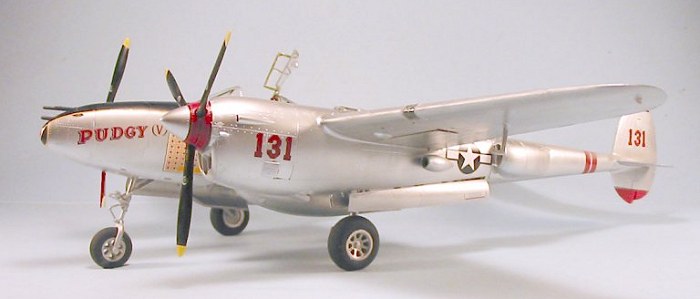
Trumpeter 1/32 P-38L Lighting
|
KIT # |
? |
|
PRICE: |
$129.95 MSRP |
|
DECALS: |
One option |
|
REVIEWER: |
Tom Cleaver |
|
NOTES: |

|
HISTORY |
The Career of Thomas B. McGuire Jr. (Continued):
May 1944 saw McGuire promoted to command the 431st Fighter Squadron and start scoring again in his P-38J-10, the third “Pudgy.” e kept scoring regularly through the summer as the campaign in New Guinea came to an end and the 475th moved on to Halmahera Island, a place located between New Guinea and the Philippines, where the next stage of the Southwest Pacific offensive would take place. While there, McGuire met the tech rep of United Aircraft, who was studying the use of aircraft and equipment built by the company under combat conditions. He was Charles A. Lindbergh, and his presence with the 475th would change the unit forever.
Up to this point, the P-38 was commonly considered to have a flight time of 2-3 hours, depending on weather and combat conditions. In fact, the limiting factor was that the wingmen used more fuel than their leaders; additionally, pilots were not instructed in fuel management during training. The pioneering Lindbergh, once he familiarized himself with the P-38, thought he could teach the pilots something useful that would extend their range. At first, most of the pilots were reluctant to believe what Lindbergh said was possible; this wasn’t because they didn’t believe Lindbergh - they just didn’t believe they were as good a pilot as this legend. Lindbergh had hooked up with McGuire early in his visit, recognizing a fellow spirit, and the two were sharing a tent by this time. McGuire understood immediately what Lindbergh was talking about, and told his squadron mates that the secret wasn’t some esoteric something that only a great pilot could do - it was something anyone could do once they knew how.
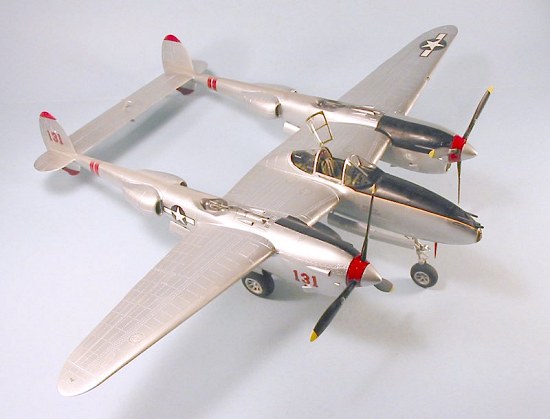 With this
endorsement from their squadron leader, the pilots of the 431st Fighter
Squadron began training with Lindbergh. The “secret” was to lower revs
and raise manifold pressure during cruise, cutting fuel consumption by a
third. This effectively tripled the P-38's range, and the three
squadrons of the 475th were soon flying missions that lasted
6-7 hours and ranging as far away as Balikpapan in Borneo. With this
increase in flight time, they could escort 5th Air Force
bombers all the way to targets where the Japanese didn’t expect to meet
U.S. fighters. The 475th racked up more victories.
With this
endorsement from their squadron leader, the pilots of the 431st Fighter
Squadron began training with Lindbergh. The “secret” was to lower revs
and raise manifold pressure during cruise, cutting fuel consumption by a
third. This effectively tripled the P-38's range, and the three
squadrons of the 475th were soon flying missions that lasted
6-7 hours and ranging as far away as Balikpapan in Borneo. With this
increase in flight time, they could escort 5th Air Force
bombers all the way to targets where the Japanese didn’t expect to meet
U.S. fighters. The 475th racked up more victories.
In August, 1944, McGuire traded in his third “Pudgy” after a crash for a new P-38J-15LO equipped with dive flaps, which was formally named “Pudgy IV”. With the dive flaps, there was no maneuver a P-38 pilot had to be afraid of, and the 475th were finally able to fly their big fighter to the limits of its performance without restriction.
The invasion of the Philippines came on October 24, 1944. Within a week, the 431st Fighter Squadron was alerted to move into Tacloban Airfield on the island of Leyte. As McGuire led his squadron in to land, a formation of Japanese Ki.43s swept over the field in a surprise strafing attack. The 431st were sitting ducks with gear and flaps down in the circuit. McGuire, moments from touchdown, retracted gear and flaps, increased power and pulled up and around to shoot down two of the intruders in a masterful display of flying ability, his Lightning being in the worst part of its flight envelope to undertake combat.
Within hours of arrival, the squadron were directed to hand their P-38s over to the rival 49th Fighter Group, also on the field. McGuire’s gaudily-painted “Pudgy IV” was stripped of her markings and scoreboard, and handed over. For McGuire it was frustrating to be grounded this way, inasmuch as Bong was flying with the 49th and scoring in the “target-rich” environment of the Philippines.
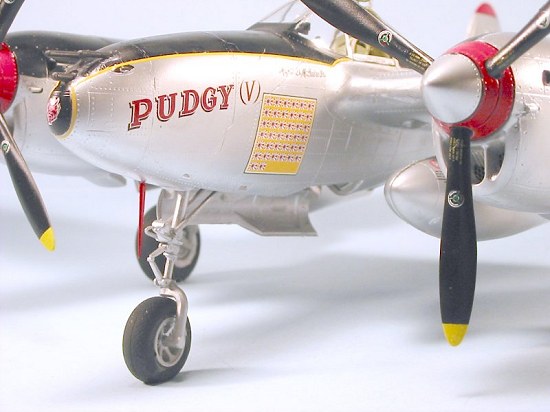 Within days
the pilots were overjoyed they’d had to hand over their airplanes, as the
431st was completely re-equipped with brand-new P-38L-5LO
aircraft. The P-38L was finally the “Lightning” everyone had wanted from
the outset. With hydraulic controls and dive flaps, the P-38L could take
on any enemy aircraft in complete confidence.
Within days
the pilots were overjoyed they’d had to hand over their airplanes, as the
431st was completely re-equipped with brand-new P-38L-5LO
aircraft. The P-38L was finally the “Lightning” everyone had wanted from
the outset. With hydraulic controls and dive flaps, the P-38L could take
on any enemy aircraft in complete confidence.
McGuire’s airplane was named “Pudgy V”, and he left the 431st Fighter Squadron as he was promoted to Group Operations Officer, though he would continue to fly with the unit on missions.
By the beginning of December, McGuire had “found his groove” and raised his score to 31. Bong in the meantime had raised his score to 40 and was sent home as the Ace of Aces. McGuire was determined that would not be a record his rival would hold that long.
On December 25, 1944, McGuire volunteered to lead 15 P-38s to provide escort to B-24s in a strike against Mabalacat Airfield on Luzon. Over the enemy base, 20 Zeros met the American attack. In a wild dogfight, McGuire shot down three of the Zeros. The next day, McGuire again led the escort to Mabalacat, and again the Japanese came up to contest the raid. As one Zero bored in on a B-24, lighting one engine on fire, McGuire opened up at the extreme range of 400 yards in a 45-degree deflection shot, and blew the Zero out of the sky. He then proceeded to mow down three more Zeros, bringing his score to 38.
It was obvious to everyone that with air combat in the Philippines running like it was, that McGuire would break Bong’s score any day, perhaps on his next mission. Major General Kenney ordered McGuire grounded, telling him that he couldn’t go up again until Bong had at least had time to get home and receive his Medal of Honor and recognition as the Ace of Aces. All McGuire could say was “yes, sir, General.” His intentions were clear as a bell for everyone to see as he had his crew chief paint the two victories he had lost through a cut of the cards back in 1943 onto the scoreboard on the nose of “Pudgy V,” along with two white flag backdrops waiting to be filled in with the rising sun. 42 it was going to be. And soon.
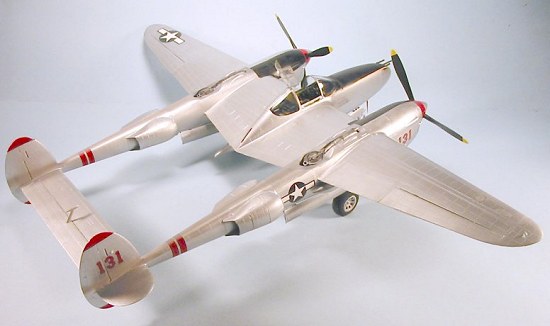 On January 7th,
1945, McGuire was turned loose as it was announced Bong had been
decorated. “Pudgy V” was down for maintenance that morning as McGuire
took off in a borrowed P-38 leading a flight of four that included
Captain Edwin Weaver as his wingman; Major Jack Rittmayer flew element
lead with 1st Lt. Douglas Thropp as his wingman. The mission
was a fighter sweep of Negros Island, where a large force of Japanese
aircraft was known to be based. Each P-38 carried full fuel and two
160-gallon drop tanks for maximum range and flying time. The foursome
expected to run across Japanese fighters, and everyone believed that
McGuire would return to Dulag Airfield with the victories necessary to
flesh out the scoreboard on ”Pudgy V.”
On January 7th,
1945, McGuire was turned loose as it was announced Bong had been
decorated. “Pudgy V” was down for maintenance that morning as McGuire
took off in a borrowed P-38 leading a flight of four that included
Captain Edwin Weaver as his wingman; Major Jack Rittmayer flew element
lead with 1st Lt. Douglas Thropp as his wingman. The mission
was a fighter sweep of Negros Island, where a large force of Japanese
aircraft was known to be based. Each P-38 carried full fuel and two
160-gallon drop tanks for maximum range and flying time. The foursome
expected to run across Japanese fighters, and everyone believed that
McGuire would return to Dulag Airfield with the victories necessary to
flesh out the scoreboard on ”Pudgy V.”
Once over Negros, weather forced McGuire’s flight to depart their patrol altitude of 10,000 feet and descend to 6,000 feet. They circled the area of Fabrica Airfield for 10 minutes in a futile attempt to provoke a fight. By this point they were down to 1,000 feet; as McGuire turned west, it was apparent Rittmayer had become separated from the rest; he reported engine trouble and aborted the mission. McGuire ordered Thropp to assume Number Three. As they flew toward another Japanese field on the western end of Negros, Weaver spotted a Ki.43 “Oscar” below them.
Accounts have differed over the years about what happened next. Knowledgeable researchers now believe that McGuire “gave” the Oscar to Weaver, who needed one more victory to make Ace. To the Americans, the Oscar was just another chump airplane piloted by another poor Japanese pilot; “meat on the table.”
The Oscar was in fact flown by Warrant Officer Akira Sugimoto, an experienced instructor pilot with hundreds of hours in the very maneuverable Japanese fighter. As Weaver dove on Sugimoto’s Oscar with Thropp on his wing, Sergeant Minoru Fukuda, flying a new Ki.84 “Frank” was in the process of landing at the nearby field. He saw his friend’s predicament - sucking up his gear and pulling full power, Fukuda flew to Sugimoto’s aid. Like Sugimoto, Fukuda was an experienced pre-war trained pilot and instructor, who was thoroughly familiar with his mount. Tom McGuire was about to meet the two most dangerous Japanese fighter pilots in the Philippines.
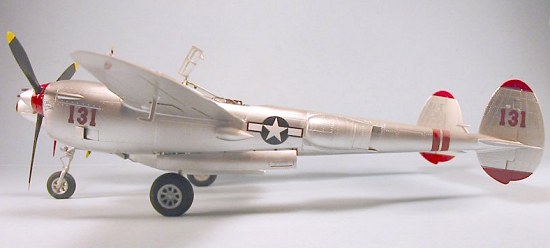 Sugimoto hit
Thropp with a well-aimed burst and destroyed one of the turbochargers. As
Thropp was about to punch off his tanks, McGuire ordered him not to. No
one has ever been able to know why this experienced fighter pilot would
give an order that violated everything he knew about air combat, but most
researchers believe he wanted to knock off what he saw as an ordinary Jap
plane, and then maintain the mission.
Sugimoto hit
Thropp with a well-aimed burst and destroyed one of the turbochargers. As
Thropp was about to punch off his tanks, McGuire ordered him not to. No
one has ever been able to know why this experienced fighter pilot would
give an order that violated everything he knew about air combat, but most
researchers believe he wanted to knock off what he saw as an ordinary Jap
plane, and then maintain the mission.
Rittmayer overcome his engine problem and turned back to rejoin the flight. He found himself in an advantageous position and fired on Sugimoto to draw him off Thropp. Instead of breaking from the fight, Sugimoto used the Oscar’s tight turning ability to bring himself around and open fire on Weaver. Under fire from an enemy who was turning out to be much more dangerous than expected, Weaver called for help and McGuire came down to nail Sugimoto.
However, at that moment he must have spotted Fukuda’s Frank as the Sergeant set up for an attack and turned toward him. McGuire was at low level, in a heavy airplane; as he increased the angle of bank geometrically, the stalling speed of the big Lockheed increased logarithmically, and the big Lightning shuddered on the edge of a high-speed stall, only a few hundred feet above the jungle canopy.
No one saw exactly what happened next.
Weaver had lost sight of McGuire as he flew for his life to get away from the deadly Sugimoto, who was being chased by Rittmayer and Thropp and at that moment turned away from Weaver to get away from his pursuers. A moment later, Weaver looked out and saw an gasoline explosion in the jungle below.
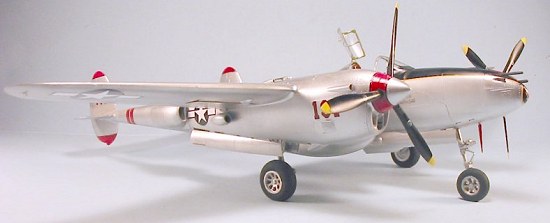 Rittmayer and
Thropp chased Sugimoto and Thropp managed to put a burst into the Oscar
that killed the pilot. As the Oscar went down, Fukuda attacked Thropp.
Weaver had recovered and he fired at Fukuda to save Thropp. Rittmayer
turned in to go after Fukuda, but was outflown by the Japanese ace, who
put a fatal burst into Rittmayer’s P-38 - the big silver fighter crashed
and exploded just outside the village of Pinanamaan.
Rittmayer and
Thropp chased Sugimoto and Thropp managed to put a burst into the Oscar
that killed the pilot. As the Oscar went down, Fukuda attacked Thropp.
Weaver had recovered and he fired at Fukuda to save Thropp. Rittmayer
turned in to go after Fukuda, but was outflown by the Japanese ace, who
put a fatal burst into Rittmayer’s P-38 - the big silver fighter crashed
and exploded just outside the village of Pinanamaan.
As Rittmayer went down, Fukuda fired again at Thropp, who managed to escape into a cloud. Weaver tried to catch Fukuda, who eluded him in the low clouds. After ten fruitless minutes spent trying to find and join up with McGuire, Weaver returned to Dulag to tell the tale with Thropp.
How did it happen?
This past spring, Doug Thropp, the sole surviving American witness to the death of Tom McGuire, planned to come out to Chino for the reunion of P-38 pilots on May 15; he was to meet Fukuda, who was coming to the celebration as a member of the Zero Pilots Association of Japan. Unfortunately, Thropp - who had been in fragile health - died in late April. When asked at Chino what he could say about the fight, Fukuda responded through an interpreter, “I did not shoot at McGuire.”
Many researchers believe that the laws of aerodynamics killed McGuire: one doesn’t rack a heavy P-38 into a wings-vertical tight turn with only a couple hundred feet below to get out of the inevitable stall/spin. Thus, Tom McGuire has gone down as the ace the enemy couldn’t kill. Other researchers now believe it was possible that as Sugimoto turned to get away from Thropp and Rittmayer, McGuire might have seen him coming in on his tail, and that it was this event that made him tighten his turn past those warning shudders. Sugimoto might have opened fire and hit McGuire just at the moment when he needed maximum concentration on what was about to happen to his airplane.
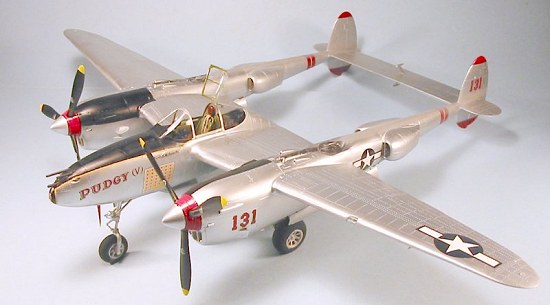 There are none
left to tell the tale with any certainty. What is certain is that Thomas
B. McGuire is forever frozen in history as America’s Second Ace, a
position no one is likely to ever knock him out of. His name lives on in
the Air Force, with McGuire AFB in New Jersey named for him.
There are none
left to tell the tale with any certainty. What is certain is that Thomas
B. McGuire is forever frozen in history as America’s Second Ace, a
position no one is likely to ever knock him out of. His name lives on in
the Air Force, with McGuire AFB in New Jersey named for him.
Ironically, McGuire did win the Medal of Honor he wanted - not for being the top ace as he had hoped, but for being the brave leader in the two missions of December 25 and 26, 1944.
Tom McGuire truly was a hero as he wanted to be - the men who flew with him considered him an inspiration to the others. When his scoring record is compared with other ace pilots, his skill as a flyer and a deadly shot stands out, even over Bong. Where other pilots considered themselves fortunate to shoot down one enemy airplane in a dogfight, McGuire regularly scored multiples. Sent back to the States with 27 victories, Bong had to request he be sent to gunnery school to return able to shoot as well as McGuire did on his first mission over Wewak when he knocked down four Zeros. Of the two, who was the best? Myself, I think it was a tie. Tom McGuire nailed those two he lost to the cut of the cards and proved himself the gentleman so many claimed he wasn’t when he accepted that outcome without argument.
|
THE KIT |
Please visit the preview for a look at what comes in the box.
|
CONSTRUCTION |
This was an out-of-the-box build, with the exception of using a Rutman resin seat in the cockpit with Cutting Edge posable resin seatbelts, Rutman resin tires, and correcting the propeller blades by cutting each blade off the hub and extending it 3/16" to obtain a proper diameter, this being the one serious mistake in the kit.
As with my
other Trumpeter kit, I did not propose to use the engines or the nose
armament detailing sets, due to the fact of the need for extensive
scratchbuilding of the cowling interior structure for the engines.
Additionally, without the extra weight of the resin conversion parts for
the cowling on the P-38H, I found I needed every square centimeter of
interior space in the front end of the engine cowlings and the central
nacelle nose to be full of weight in order to get a nose-sitter out of
the kit with the extended oleo section of the nose wheel, which elevated
the nose an additional 1/4" and added to the “tilt” of the
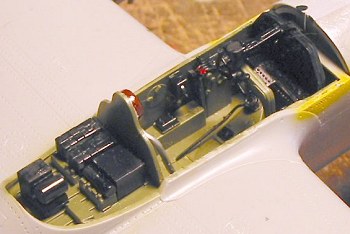 final stance of the
model.
final stance of the
model.
Beyond the propeller diameter correction, which is an easy bit of work to accomplish, I also needed to glue in and then sand over the circular clear part on the interior side of the engine cowlings; on the real airplane, there is an oval of chrome metal here, to enable to pilot to confirm that the wheels are up or down. This involved gluing the part in place, sanding it smooth, covering it with Mr. Surfacer and sanding smooth again, then rescribing the engraved rivet detail with my pounce wheel.
The central nacelle will need Mr. Surfacer in all the nose panel joints and a good sanding down to get everything smooth; this then requires use of the pounce wheel to rescribe detail. I also needed Mr. Surfacer on the centerline seams of the two engine booms, which also meant rescribing countersunk detail once everything was sanded smooth. If you take care to precisely fit the parts throughout construction, you can minimize this, but you cannot get away from it.
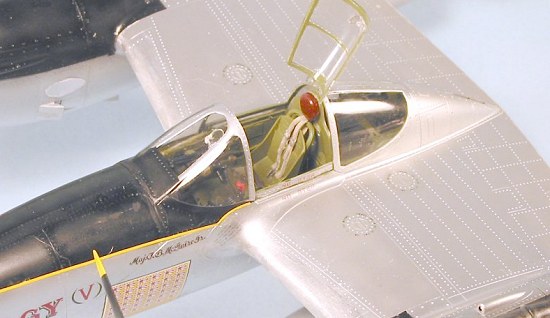 Past these
points, the model presents no difficulty in construction other than there
are a lot of parts. Again, I glued the separate control surfaces to the
various wing, elevator and boom halves before proceeding with
construction so they could be glued from inside, which leaves the
external joint looking clean as it should be.
Past these
points, the model presents no difficulty in construction other than there
are a lot of parts. Again, I glued the separate control surfaces to the
various wing, elevator and boom halves before proceeding with
construction so they could be glued from inside, which leaves the
external joint looking clean as it should be.
The cockpit was assembled stock, other than the above-mentioned resin seat, and the end result looks very good. In fact - as with the Messerschmitt Bf-109 cockpits, this cockpit is indistinguishable from the resin cockpit I used on the P-38H at any distance further than 12 inches away. The canopy parts were dipped in Future before assembly and fit precisely with no need of filler in the seams.
As with the earlier kit, I assembled the landing gear as I assembled the wheel wells - which is the way the instructions call - because the wheel wells of a P-38L are unpainted natural metal like the rest of the airframe.
|
COLORS & MARKINGS |
I have taken a walkaround series of photos on a sunny day of the Planes of Fame P-38L-5LO, which is the only for-real natural metal finish P-38 in the world. Interestingly, the P-38 structurally is made of the same kind of metal throughout, other than the areas around the turbo exhausts, and the only tonal differences are those created by differing reflectivity caused by the shape of a particular part. For those who disbelieve, here are a series of these pictures for your review.
I first painted the anti-glare panels, first with Tamiya “Semi-gloss Black,” then filling in the panels with Tamiya “NATO Black.” I used Tamiya “Insignia Red” for the vertical fin tips and the spinners, since this shade of red matched the red in the decals I was going to use. Once dry these areas were masked off and it was time to go for the overall natural metal finish.
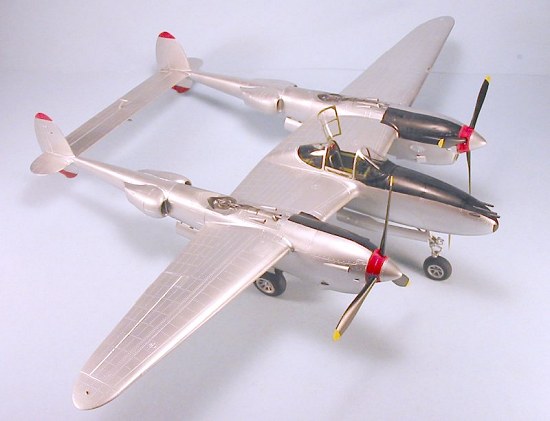 This kit is
easily the largest NMF paint job I have ever attempted. I decided to
give the entire model a base coat of SNJ Aluminum, followed up by a light
coat of Alclad II “Polished Aluminum,” followed by light coats of SNJ on
differing surfaces, in order to create some tonality difference in
reflectivity. The model is big enough that it took half a bottle of SNJ
to provide a basecoat with no “holidays.” I then painted the panels
around the turbo exhausts with Testor’s Model Master “Stainless Steel”
overcoated with MM “Steel”. The turbo exhausts were airbrushed with MM
“Magnesium” then drybrushed with MM “Burnt Iron” for highlights.
This kit is
easily the largest NMF paint job I have ever attempted. I decided to
give the entire model a base coat of SNJ Aluminum, followed up by a light
coat of Alclad II “Polished Aluminum,” followed by light coats of SNJ on
differing surfaces, in order to create some tonality difference in
reflectivity. The model is big enough that it took half a bottle of SNJ
to provide a basecoat with no “holidays.” I then painted the panels
around the turbo exhausts with Testor’s Model Master “Stainless Steel”
overcoated with MM “Steel”. The turbo exhausts were airbrushed with MM
“Magnesium” then drybrushed with MM “Burnt Iron” for highlights.
Decals:
I used Eagle Editions Decals EC#72 “P-38 Lightnings” which provides the markings for “Pudgy V”. The decals went on with no problems under a coat of Micro-Sol.
Once the decals were on, I discovered that handling the model while applying the decals had worn off the paint on the leading edge of the wing between the central nacelle and the engines. I was not about to mask over the decals, so I hand painted the panel area of the leading edge and now only handle the model by the lower rear of the central nacelle, or by the radiator fairings on the booms.
|
FINAL CONSTRUCTION |
I attached the resin tires to the plastic hubs and glued the wheels to the landing gear after sanding a flat spot on each tire. I attached the propellers to the hubs and glued these to the engine nacelles. I glued the raised lid of the cockpit canopy in position, along with the side windows, which I had cut so that only parts of the upper edges were there, as if they had been rolled down.
Exhaust staining was done on the upper booms with a thinned mixture of Tamiya “Dark Sea Grey” with a dash of thinned Tamiya “Smoke” on that.
|
CONCLUSIONS |
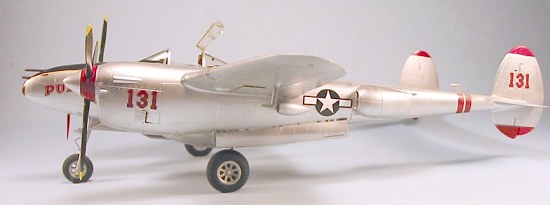 It’s big and
it’s bright silver!!
It’s big and
it’s bright silver!!
I am now definitely convinced that this P-38L is Trumpeter’s best kit to date, and the best P-38 model available in any scale. Don’t let the hundreds of parts in the box scare you off. As the old Chinese saying goes, “The journey of a thousand miles begins with the first step.” Take your time, test fit the parts to insure good fit, be careful gluing parts in position, and you can indeed do a great big 1/32 kit in a natural metal finish that will look good at the end.
Kit courtesy of my wallet. Decals courtesy Eagle Editions. SNJ paint courtesy SNJ Model Products.
June 2004
Copyright ModelingMadness.com. All rights reserved. No reproduction in part or in whole without express permission.
If you would like your product reviewed fairly and fairly quickly, please contact the editor or see other details in the Note to Contributors.